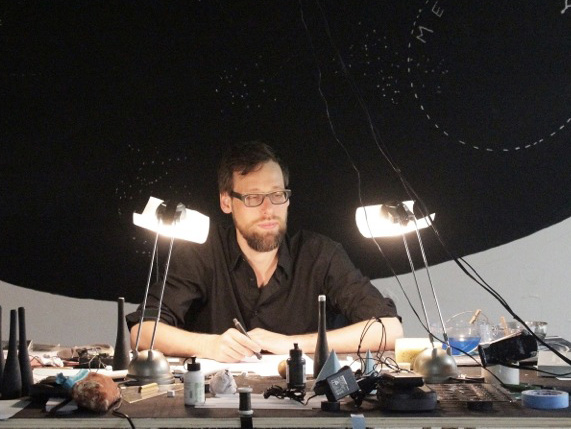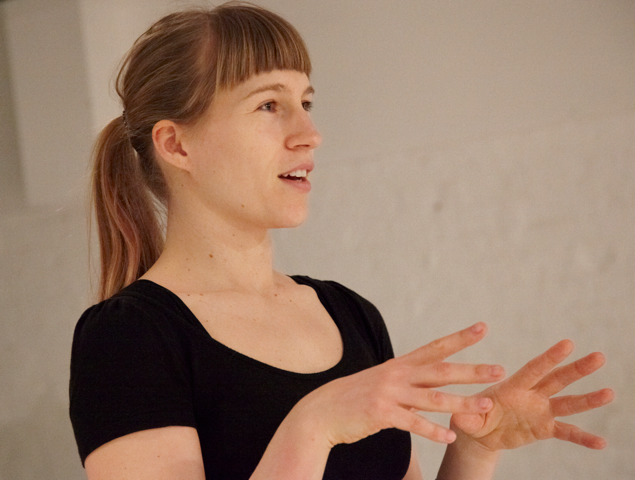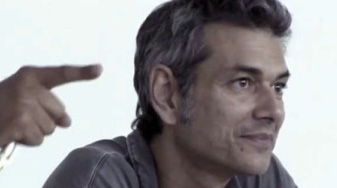Andrea BožićDay for Night
This performance is a once in a 500,000 years event.
For the 20th of March, the beginning of spring in the Northern Hemisphere and autumn in the Southern, Andrea Božić has prepared a spectacle titled Day for Night (Total Eclipse of Equinox Sun). The piece features a total eclipse of the Sun that will turn day into night at the moment of the same length of day and night in the whole world. The eclipse of the sun will interrupt this equilibrium of light and darkness.
The premium seats for the performance are at the North Pole. As the sun rises at the horizon for the first time after six months of darkness at the North Pole, the Moon covers the Sun and day becomes night again. The performance will affect all our senses: the temperature falls, insects and birds stop making sounds, the tides get more extreme and the landscape changes dramatically in only a few moments. We are in the Moon’s shadow and we see the Moon’s dark side. Dreams and secrets emerge in the dark.
Seats for the performance in the Moon’s shadow are unlimited but visibility depends on your area. The Netherlands, where we are based, will enjoy the spectacular 87% visibility. For further instructions on how to attend the performance: choreographyinvestigations.blogspot.nl
André EiermannLooking through an awry lens
To look at art through the lens of theatre – this has, since the proclamation of a so-called performative turn, become a matter of course in the field of theatre studies. But while the lens which is usually applied for this purpose, i.e. the understanding of theatre, remains shaped in most cases by an anthropocentric concept of performance defined on the basis of inter-human encounter, this concept is recently challenged by certain developments in contemporary performing arts. Non-human performers like animals or objects appear. Animated items, substances in motion, and acousmatic voices interfere with or even replace the human body’s presence. Performances occur partly or even entirely without human performers. In this lecture, André Eiermann asks what kind of consequences such developments entail, and what it means to look at art through a lens correspondingly curved.
Nikolaus Gansterer Habeas Corpus Ad Subjiciendum, or Body of Work? You’re Looking at It
Translectures are translations. They transform one thought into another. They are also invitations to understand and interpret one reality through another.
How far can a drawing – a medium of high immediacy – become tool of communication, a score, and again an instruction for taking action? Nikolaus Gansterer presents his time-based fragile drawings and models as a rigorous development of a specific language for the materialisation of thought processes and a playful way of dealing with the complex levels of speculative knowledge. For Gansterer, Translectures are an open, performative model where live inscription fuses live-drawing, staging the unfolding of his on-going research through presentation rather than re-presentation.
Maximilian HaasAnimal Agency
Higher animals resemble humans in so many ways that philosophy and art have always felt obliged to determine the differences. Western modernity even considers man and animal to be opposites. It is only the human being who possesses language systems, consciousness and social manners, characteristics distinguishing us from the animal. Whether as the zoon politikon, the animal rationale, or – in essentially modern terms – the body-machine that thinks, there is unquestionably one thing man is not: an animal amongst animals. In Animal Agency, Maximilian Haas looks into man’s exceptional position among other worldly lifeforms, marked by the distinction between intention and instinct.
Reality is divided into two worlds: we inhabit one world, they inhabit the other. Ours is called culture and is created by free subjects, while theirs is called nature and contains living objects, which, however, are without any cognition or will. Empirical encounters with animals, especially in the reinforcing frame of (contemporary) art and theatre, draw a very different picture: Usually the works do not simply show an animal, but always this one animal. Lending their motifs both face and figure, an individual aura, they invite the beholder to speculate about the subject’s biography, character, emotions and passions. In short, they lend the animal subjectivity and highlight its (non-human) agency.
David Weber-KrebsPerformance (Robert Morris revisited)
What is it with the spectacular? To find out, on as to go back to a historic period in modern art, that was seemingly defined by an unparalleled will to be anything but spectacular: the minimalism of the 1960s. Of course, doing little can be quite unspectacular, but doing very little is again most spectacular. And it was. So how is something unspectacular turning into something spectacular? Is it the thought, the speculation, or is it the sight, the spectacle?
Performance is a spectacle and a speculation telling the true story of how the American artist Robert Morris injured his head in 1961.
Concept and realization by David Weber-Krebs, in collaboration with Jan-Philipp Possmann. Technical realization by Hans Wenstendorp; produced by Infinite Endings and Frascati.
Mette IngvartsenSpeculations
In this discursive-practice-performance, Mette Ingvartsen uses imagination, speculation and description, three differently charged modes of address, to develop ideas in front of an audience. The spectator is not directly participating in the performance but is nevertheless playing an active role in the encounter. Ideas around artificial nature, catastrophic constructions and the autonomy of objects are being processed through talking, gesturing and moving. Speech and physical actions are given equal value, while being used to materialize a virtual performance within the mind of the spectator. Concept and performance by Mette Ingvartsen. Production Management by Kerstin Schroth. Production by Mette Ingvartsen/Great Investment with support from Summer Intensive 2011, organized by Christine De Smedt/les ballets C de la B and DOCH (University of dance and circus, Stockholm).
André LepeckiIn the dark
In this talk, André Lepecki shares his research and interests in what might be revealed in the dark by considering some recent performances where darkness is the key element of an illumination without light. Following recent theoretical-aesthetic propositions by Fred Moten, Mette Ingvartsen, Jonathan Crary and Tino Sehgal, Lepecki explores the ways that darkness offers us the possibility of a collective modality of experience, where de-personalisation and speculation propose an non-enlightened critical stance and a more resonant aesthetics, away from photological (science of light) imperatives.
Jeroen PeetersIt lay like a log absolutely motionless and apparently deprived of all its faculties by our damp climate, so inhospitable to foreign visitors
Now that artistic practices often operate in an expanded, interdisciplinary field, pursue anthropological interests, or are in search of new places to thrive outside of the traditional institutions – how can we still recognize artistic gestures? How can we tell them apart from social and political practices? From journalism and the daily flood of images that surround us? What if we’d approach the ways we see, hear, sense and imagine art as an ‘ecology of attention’ – would we discover a conceptual landscape populated with animals, plants and objects that somehow clarifies the medial character of the cultural ecosystems we embody? Jeroen Peeters will explore these questions through a single trope: the crocodile, a predator that devours language and culture to then retreat like a heavy, taciturn creature to the river bottom of many books and film
9:29 – 11:48 (final location tbd by weather, meet at de Brakke Grond) 1 bit
Andrea Božić perfomance Day For Night led by David Weber-Krebs & Julia Willms
Keep Knotting Notes performance by TXT department students (while EXPOZAAL doors open)
SLOT 1
12.30 - 14.302 bits
Introduction to today's program by David Weber-Krebs
Animal Agency by Maximilian Haas
It lay like a log absolutely motionless and apparently deprived of all its faculties by our damp climate, so inhospitable to foreign visitors by Jeroen Peeters
(15min break)
SLOT 2
14.45 - 16.45
2 bits
Performance (Robert Morris revisited) by David Weber-Krebs RODE ZAAL
Screening excerpt from Five by Abbas Kiarostami + the making of
Looking through an awry lens by André Eiermann
(15min break)
SLOT 3 17.00 - 19.00 2 bits
In the dark by André Lepecki
Performance Speculations by Mette Ingvartsen RODE ZAAL
(Limited seats available – reservations at the front desk Thursday & Friday)
Full Attendance 7 bits
** Nikolaus Gansterer's Translectures will be performed throughout the day in the EXPOZAAL.
** IMPORTANT: Speculations by Mette Ingvartsen in the RODE ZAAL has limited seats available – please make reservations at the front desk Thursday & Friday.
**MASTERCLASS SESSIONS for Rietveld Students
Esteemed guests of Are You Alive Or Not?, Claire Tancons (curator from New Orleans) and Dmitry Vilensky (member of the collective Chto Delat from Petersburg) will be leading two separate peripatetic sessions through the Rietveld Uncut exhibition, with a small group of students (maximum of 20). These conversational sessions will revolve around the students’ work as seen through the conceptual lens of the conference.
Each Masterclass addresses predominantly the Rietveld Uncut participants but it is also open to any student of the Rietveld Academie.
Reservations can be made at the front desk during Thursday, Friday and Saturday afternoon.
Friday, March 20 with Claire Tancons 10.30 - 12.30 2 bits
Saturday, March 21 with Dmitry Vilensky 17.15 - 18.30 2 bits







